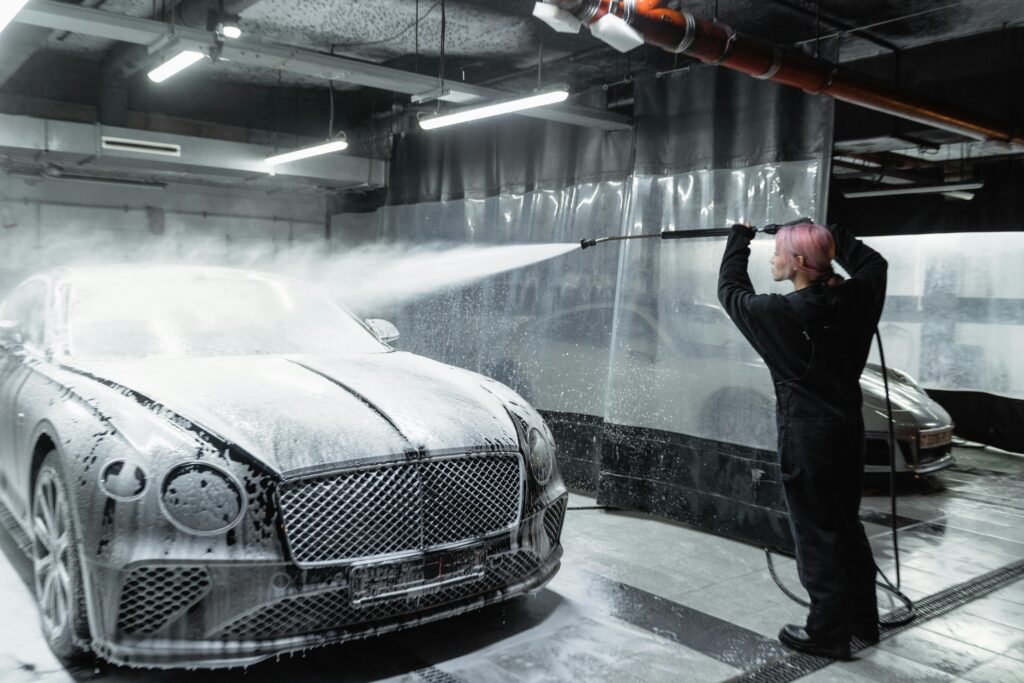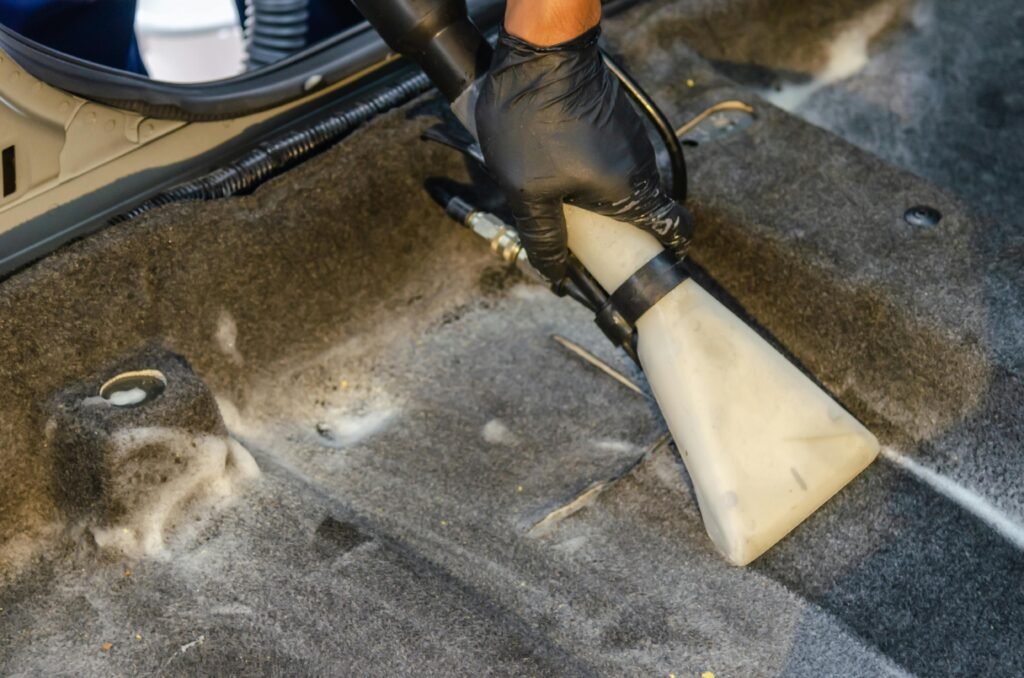Car detailing is more than just a simple wash; it’s a meticulous, thorough process that revitalizes your vehicle, both inside and out. Whether you’re a car enthusiast or just someone who wants to maintain the appearance of your car, detailing is essential for preserving its value and enhancing its aesthetic appeal. In this comprehensive guide, we’ll explore the world of car detailing, how it differs from a regular car wash, and the best products and techniques for achieving professional-level results. Ready to take your car’s appearance to the next level? Let’s dive in.
What is Car Detailing?
Car detailing involves a deep cleaning, restoration, and finishing of a vehicle, both inside and out, to bring it to a showroom-like condition. Unlike a regular car wash, which primarily focuses on the exterior, detailing goes beyond the surface. It’s a process that includes everything from waxing and polishing to interior cleaning and leather conditioning. Detailing helps protect your car from the elements, restores its shine, and prolongs its life.
Why is Car Detailing Important?
- Protects Your Investment
Your car is one of the most significant investments you’ll make, and keeping it in top shape is essential. Regular detailing helps prevent the build-up of dirt, grime, and contaminants that can damage the paint or degrade the interior surfaces over time. - Increases Resale Value
A car that’s been properly detailed will always fetch a higher resale price. If you plan to sell or trade in your car in the future, detailing it before listing will make it stand out and increase its market value. - Enhances Aesthetics
A well-maintained car simply looks better. The glossy shine of freshly polished paint, the clean smell of a detailed interior, and the sparkling wheels all contribute to the overall appeal. When your car looks good, it makes you feel good. - Improves Safety
Detailing also contributes to the safety of your vehicle. Clean headlights, taillights, and mirrors improve visibility, and a detailed engine bay can help prevent overheating and improve the performance of your car.
The Step-by-Step Process of Car Detailing
Step 1: Exterior Wash and Dry
The first step in any car detailing process is to clean the exterior. Begin by rinsing your car with water to remove any loose dirt. Then, using a high-quality car wash soap (we recommend Carpro Reset), wash the surface using a microfiber mitt. Be sure to clean the wheels and tires as well, using a specialized wheel cleaner such as Carpro Wheel & Tire Cleaner Spray. Rinse thoroughly and dry with a soft microfiber towel to avoid water spots.
Step 2: Clay Bar Treatment
After the initial wash, the next step is clay bar treatment. Clay bars remove contaminants like tree sap, industrial fallout, and other pollutants from your car’s paint that a regular wash can’t reach. Using a lubricating spray like Chemical Guys Clay Luber, gently glide the clay bar across the surface to remove these impurities.
Step 3: Polishing
Polishing your car’s paint restores its shine and removes light scratches or swirl marks. Apply a quality polish such as Sonax Profiline Perfect Finish and use a dual-action polisher for even coverage. If you’re working by hand, use a microfiber cloth to buff the polish into the paint in a circular motion.
Step 4: Waxing or Sealing
To protect the paint, a layer of wax or sealant is applied. Wax provides a deep shine and hydrophobic protection, while sealants are designed for longer-lasting protection. We recommend using Turtle Wax Ice Seal N Shine for a durable, glossy finish that lasts for months.
Step 5: Interior Detailing
Once the exterior is spotless, it’s time to focus on the interior. Start by vacuuming the seats, carpets, and floor mats using a Kärcher Vacuum Cleaner for deep cleaning. Clean the dashboard, center console, and other hard surfaces with a gentle all-purpose cleaner like Cleaning Gel. If your car has leather seats, use a leather cleaner and conditioner like Leather Cleaner to keep the material supple and protected.
Step 6: Detailing the Engine Bay
Although it’s not always necessary, cleaning the engine bay can help maintain your car’s performance. Use an engine degreaser such as WD-40 Engine Degreaser and a soft brush to remove any grime or oil residue. Always cover electrical components with plastic before spraying.
Step 7: Tires and Trim
Finish off by dressing your tires with a product like Meguiar’s Endurance Tire Gel for a glossy, wet look. Apply trim restorer to plastic trim pieces to restore their color and shine. Chemical Guys VRP Dressing is an excellent choice for this.
Recommended Car Detailing Products
To achieve the best results, you need to use the right products. Here are some of our top recommendations:
- Carpro Wheel & Tire Cleaner Spray – Versatile and effective for both interior and exterior surfaces.
- Chemical Guys Clay Luber – Lubricates the clay bar for a smooth, streak-free finish.
- Sonax Profiline Perfect Finish – Restores paint and removes imperfections.
- Turtle Wax Ice Seal N Shine – Provides long-lasting protection and gloss.
- Kärcher Vacuum Cleaner – High-performance vacuum for interior cleaning.
- Leather Cleaner – Ideal for maintaining leather seats and upholstery.
- WD-40 Engine Degreaser – Powerful formula for cleaning engine components.
By using the right tools and techniques, your car will not only look better, but it will also stay protected from the elements for longer.
How Often Should You Detail Your Car?
How often you detail your car depends on how frequently it is driven and the conditions it’s exposed to. If you live in an area with harsh winters or excessive pollen, you may need to detail your car more often. As a general rule:
- Exterior Detailing: Every 3 to 6 months
- Interior Detailing: Every 6 to 12 months
- Engine Bay Cleaning: Every 6 months
Conclusion:
Car detailing is an investment in the longevity and aesthetic appeal of your vehicle. Not only does it help protect your car from environmental factors, but it also makes driving more enjoyable. With the right products and techniques, you can maintain a showroom-quality appearance and increase your car’s resale value.
This page may contain affiliate links




Pingback: Luxury Car Paint Damage: Why Automatic Washes Ruin Your Car"